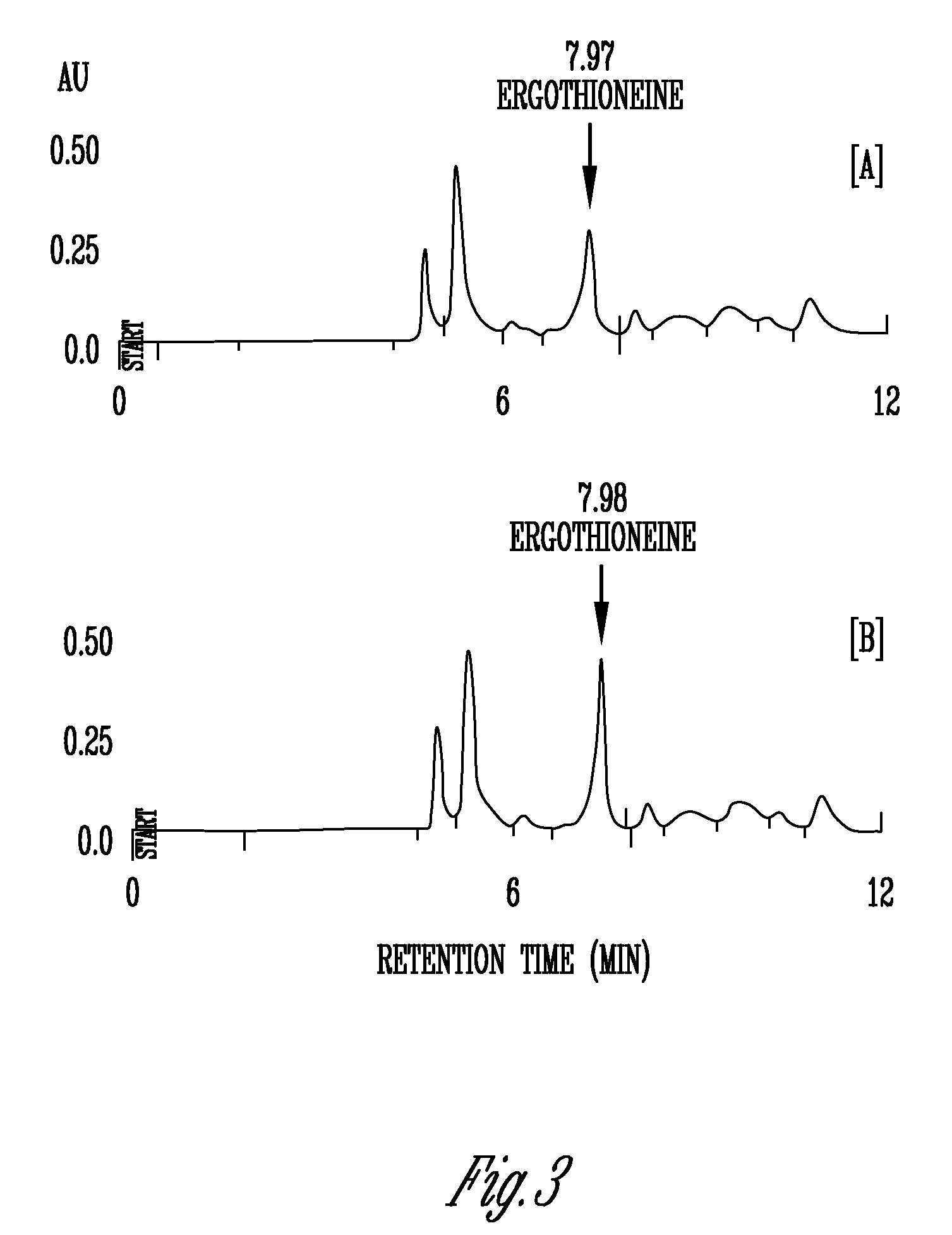Phytonutrient compositions from mushrooms or filamentous fungi and methods of use
a technology of phytonutrient compositions and mushrooms, applied in the field of pharmacology and neurology, can solve the problems of inability of mammals and humans to synthesize l-, and achieve the effects of maximizing the ergothioneine content of mushrooms, maximizing the health benefits of mushrooms, and increasing the antioxidants presen
- Summary
- Abstract
- Description
- Claims
- Application Information
AI Technical Summary
Benefits of technology
Problems solved by technology
Method used
Image
Examples
example 1
[0101]Analysis of A. bisporus mushrooms was carried out using an HPLC 600 E system controller. Separation was carried out on two Econosphere C18 columns (Alltech Associates, Deerfield, Ill.) with each column being 250 mm×4.6 mm, five-micron particle size that were connected in tandem. The degassed (ultrapure nitrogen) isocratic mobile phase was 50 mM sodium phosphate in water with 3% acetonitrile and 0.1% triethylamine adjusted to a pH of 7.3 with a flow rate of 1 mL / min. An UV-VIS 490E detector (Waters Corp., Milford, Conn.) equipped with a wavelength of 254 nm was employed. The injection volume was 10 μL with the columns temperature being ambient. Ergothioneine was quantified by monitoring absorbance at 254 nm and comparing the peak area of the sample to peak areas obtained from different concentrations of the authentic standard ergothioneine (Strip chart recorder 3392A integrator; Hewlett Packard, Palto Alto, Calif.).
[0102]Ergothioneine “spiked” samples were prepared by dissolvin...
example 2
[0106]Various mushrooms were collected and analyzed for ergothioneine content (Table 1). The A. bisporus mushrooms were grown using the standard tray system (Hartman, 1998) under standard, controlled conditions that are representative of growth conditions at mushroom farms across the country (Wuest et al., 1986). The mushrooms were harvested in optimum maturation stage with the caps closed and 2.0 to 2.5 inches in diameter. Second breaks from the A. bisporus crops were tested. Samples from the A. bisporus included in this survey were brown (crimini) mushrooms, portabella mushrooms (mature, brown mushrooms with exposed hymenia), and the common white button mushrooms. Also, in another experiment a crop of both white and brown strains of A. bisporus mushrooms were grown simultaneously using the same growing conditions and on the same compost. This experiment was conducted in order to determine if strain or stage of maturity of fruiting bodies at harvest has an effect on ergothioneine l...
example 3
[0116]Various mushrooms were collected and analyzed to measure antioxidant capacity. The most commonly consumed mushrooms in the United States, Agaricus bisporus (white, crimini and portabella), and the specialty strains, Lentinula edodes (shiitake), Pleurotus osteratus (oyster) and Grifola frondosa (maitake) were selected to determine the antioxidant capacity (radical scavenging and chelating ability) using multiple assays, including the oxygen radical absorbance capacity (ORACROO., both hydrophilic and lipophilic), hydroxyl radical averting capacity (HORAC), peroxynitrite radical averting capacity (NORAC), and super-oxide radical averting capacity (SORAC). ERG was quantified in each of these mushrooms in order to correlate this data with the antioxidant capacity assays as an indicator of whether ERG is contributing to the antioxidant capacity of the mushrooms tested. In addition, FCR was used to quantify the total phenolics (TP) of the same mushrooms in order to evaluate their con...
PUM
| Property | Measurement | Unit |
|---|---|---|
| particle size | aaaaa | aaaaa |
| pH | aaaaa | aaaaa |
| wavelength | aaaaa | aaaaa |
Abstract
Description
Claims
Application Information
 Login to View More
Login to View More - R&D
- Intellectual Property
- Life Sciences
- Materials
- Tech Scout
- Unparalleled Data Quality
- Higher Quality Content
- 60% Fewer Hallucinations
Browse by: Latest US Patents, China's latest patents, Technical Efficacy Thesaurus, Application Domain, Technology Topic, Popular Technical Reports.
© 2025 PatSnap. All rights reserved.Legal|Privacy policy|Modern Slavery Act Transparency Statement|Sitemap|About US| Contact US: help@patsnap.com



